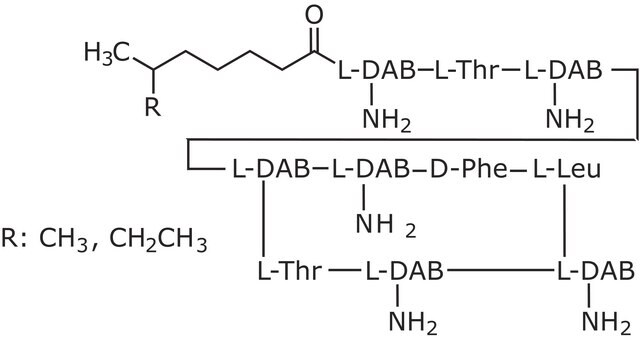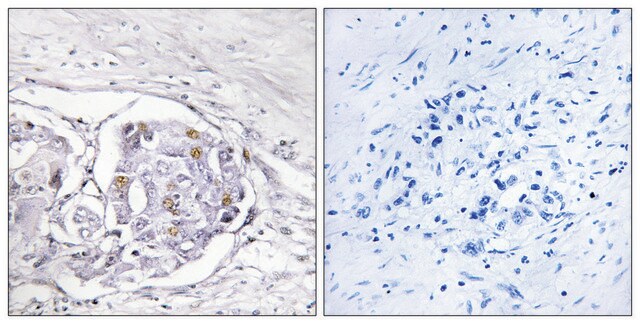推荐产品
生物源
mouse
品質等級
共軛
unconjugated
抗體表格
purified immunoglobulin
抗體產品種類
primary antibodies
無性繁殖
122.2, monoclonal
形狀
buffered aqueous solution
分子量
antigen ~180 kDa (higher band may be present)
物種活性
rat
包裝
antibody small pack of 25 μL
濃度
~2 mg/mL
技術
immunocytochemistry: suitable
immunohistochemistry: suitable
western blot: 0.2-0.4 μg/mL using total extract of rat brain
同型
IgM
UniProt登錄號
運輸包裝
dry ice
儲存溫度
−20°C
目標翻譯後修改
unmodified
基因資訊
rat ... Ptprz1(25613)
一般說明
Monoclonal Anti-Phosphacan (mouse IgM isotype) is derived from the hybridoma 122.2 produced by the fusion of mouse myeloma cells (P3X cells) and splenocytes from BALB/c mice immunized with rat brain proteoglycans. Chondroitin sulfate proteoglycans are neural cell adhesion molecules (NCAM) ligands present in the brain extracellular matrix (ECM). Phosphacan protein is expressed mainly in astrocytes and is a ligand for NCAM. Phosphacan is the soluble extracellular domain of the receptor-type transmembrane protein tyrosine phosphatase (RPTPb).
免疫原
rat brain proteoglycans.
應用
Monoclonal Anti-Phosphacan antibody produced in mouse has been used in:
- immunoblotting
- immunohistochemistry
- immunocytochemistry.
生化/生理作用
Phosphacan levels elevates during late embryogenesis. It reaches a plateau two weeks postnatal before reaching stable. Receptor-type transmembrane protein tyrosine phosphatase (RPTPb) functions to promote primary tecal neurons neurite growth, neural migration and also induces cell adhesion. Both phosphacan and RPTPb can bind to NCAM and tenascin-C and −R. Phosphacan can oppose RPTPb by competing for its binding sites. Both in hippocampal and spinal cord neurons, phosphacan can affect neuronal adhesion and neurite outgrowth.
外觀
0.01M 磷酸缓冲盐溶液,pH 7.4,含 15mM 叠氮化钠。
免責聲明
Unless otherwise stated in our catalog or other company documentation accompanying the product(s), our products are intended for research use only and are not to be used for any other purpose, which includes but is not limited to, unauthorized commercial uses, in vitro diagnostic uses, ex vivo or in vivo therapeutic uses or any type of consumption or application to humans or animals.
未找到合适的产品?
试试我们的产品选型工具.
儲存類別代碼
10 - Combustible liquids
水污染物質分類(WGK)
WGK 3
閃點(°F)
Not applicable
閃點(°C)
Not applicable
個人防護裝備
Eyeshields, Gloves, multi-purpose combination respirator cartridge (US)
Receptor protein tyrosine phosphatases in nervous system development
Johnson KG and Van Vactor D
Physiological Reviews, 83(1), 1-24 (2003)
The tissue plasminogen activator (tPA/Plasmin) extracellular proteolytic system regulates seizure-induced hippocampal mossy fiber outgrowth through a proteoglycan substrate
Wu YP, et al.
The Journal of cell biology, 148(6), 1295-1304 (2000)
Y P Wu et al.
The Journal of cell biology, 148(6), 1295-1304 (2000-03-22)
Short seizure episodes are associated with remodeling of neuronal connections. One region where such reorganization occurs is the hippocampus, and in particular, the mossy fiber pathway. Using genetic and pharmacological approaches, we show here a critical role in vivo for
RGMa mediates reactive astrogliosis and glial scar formation through TGFbeta1/Smad2/3 signaling after stroke
Zhang R, et al.
Cell Death and Differentiation, 25(8), 1503-1503 (2018)
Rongrong Zhang et al.
Cell death and differentiation, 25(8), 1503-1516 (2018-02-06)
In response to stroke, astrocytes become reactive astrogliosis and are a major component of a glial scar. This results in the formation of both a physical and chemical (production of chondroitin sulfate proteoglycans) barrier, which prevent neurite regeneration that, in
我们的科学家团队拥有各种研究领域经验,包括生命科学、材料科学、化学合成、色谱、分析及许多其他领域.
联系技术服务部门






